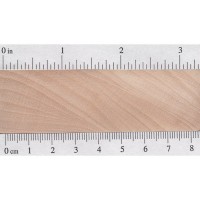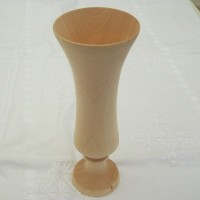 |
Common Name(s): European Lime, Common Lime, Common Linden Scientific Name: Tilia x europaea Distribution: Europe Tree Size: 65-130 ft (20-40 m) tall, 5-6 ft (1.5-2 m) trunk diameter Average Dried Weight: 33 lbs/ft3 (535 kg/m3) Specific Gravity (Basic, 12% MC): .42, .53 Janka Hardness: 700 lbf (3,100 N) Modulus of Rupture:12,380 lbf/in2 (85.4 MPa) Elastic Modulus: 1,698,000 lbf/in2 (11.71 GPa) Crushing Strength: 6,500 lbf/in2 (44.8 MPa) Shrinkage: Radial: 5.0%, Tangential: 7.5%, Volumetric: 12.0%, T/R Ratio: 1.5 |
Color/Appearance: Pale white to cream color, with only subtle growth rings. The color is mostly uniform throughout the surface of the wood. Tends to age to a yellow or pale brown color over time.
Grain/Texture: Has a fine and even texture, which is preferred for wood carvers.
Rot Resistance: European Lime is rated as being non-durable in regard to heartwood decay.
Workability: Easy to work, being very soft and light, though sharp cutters must be used during planing or other shaping operations to avoid fuzzy surfaces. Perhaps one of the most suitable wood species for hand carving. European Lime also glues and finishes well.
Odor: No characteristic odor.
Allergies/Toxicity: Besides the standard health risks associated with any type of wood dust, no further health reactions have been associated with European Lime. See the articles Wood Allergies and Toxicity and Wood Dust Safety for more information.
Pricing/Availability: Usually available only in Europe, (with Basswood taking its place in the United States), European Lime is fairly inexpensive within its natural range.
Sustainability: This wood species is not listed in the CITES Appendices or on the IUCN Red List of Threatened Species.
Common Uses: Carvings, veneer, plywood, cutting boards, hat racks, musical instruments, and turned objects.
Comments: Species in the Tilia genus are usually referred to as either Lime or Linden in Europe, while in the United States the wood is most commonly called Basswood. They are unrelated to the lime fruit in the Citrus genus. European Lime has good strength-to-weight characteristics, and tends to be slightly heavier and harder than its American counterpart.
Scans/Pictures: A special thanks to Steve Earis for providing the wood sample and turned photo of this wood species.








A bowl from linden tree , finish rubio monocoat pomegranate pink oil, inside rubio monocoat pure oil
Hi. Is European Lime available on volumes sufficient to make it a regular supply to the UK?
Thanks
Hi Eddy – Try contacting Wenban Smith (head office in Worthing, Sussex). I’m sure I saw some usefull sized Lime in stock at their Horsham branch. (Jan 2020). Regards, Jon